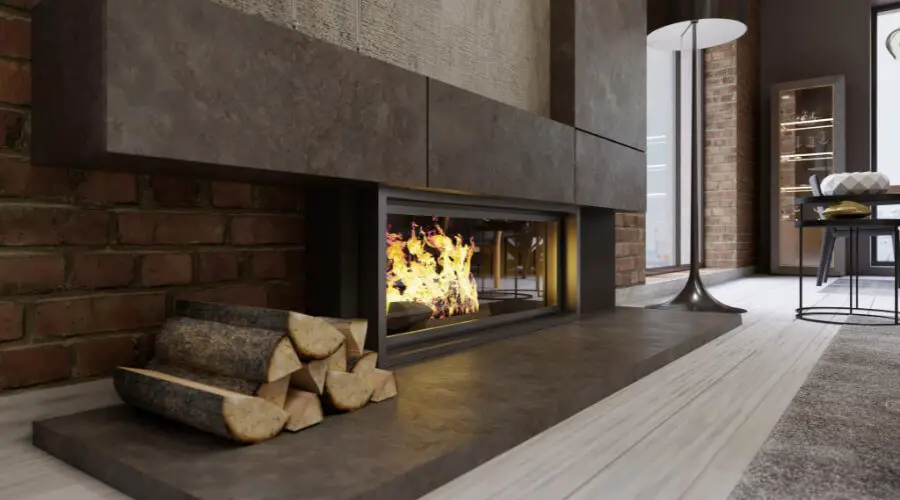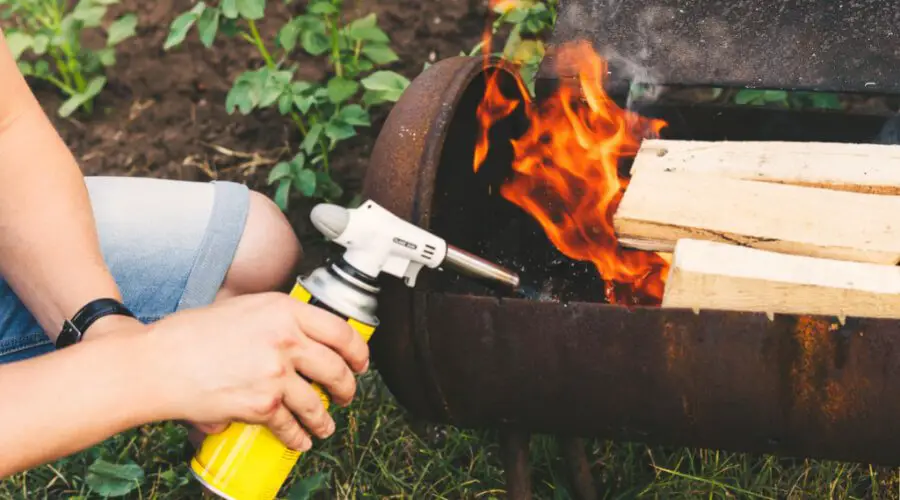Last Updated on July 24, 2023 By Emma W. Thomas
To remove a gas fireplace:
- Turn off the gas supply and disconnect the fireplace from the gas line
- Remove the decorative elements
- Detach the venting system carefully
- Unbolt and dismantle the fireplace unit
- Patch the wall and ceiling as needed
- Dispose of the fireplace components properly
What Are The Different Types Of Fireplaces Available?

The kind of fireplace you are working on may influence the steps you undertake and the tasks involved when removing it. Here are the most common types;
B-vent (Also Known As Natural Vent) Gas Fireplaces
Natural vent gas fireplaces typically occur as inserts in existing masonry fireplaces. These fixtures utilize the chimney for venting. You may not need to disconnect any vent during the process of removing the fireplace.
Ventless Gas Fireplaces
This type of fireplace vents from within, and removing them is easier compared to other models. But, they are rare than direct vent models.
Direct Vent Fireplaces
Unlike natural gas fireplaces with an open front, direct-vent fireplaces have a glass front. These fireplaces vent waste and clean air externally, and one needs to detach the vents before removing the fireplace. If there is an electricity supply to the fireplace, you will need to remove it also.
What Are The Main Steps In Removing A Gas Fireplace?

Removing the gas fireplace needs to follow specific steps, including;
Disconnecting The Gas Supply
The first step in removing a gas fireplace is to isolate the gas supply. This process involves;
- Turning off the main supply of gas to your house
- Shutting off the gas supply to the fireplace
For you to turn off the gas supply, look for a shut-off valve and turn it perpendicular to the pipe. Doing this will help disconnect the supply to the fireplace. Make sure that the professional working on the task confirms that no gas leaks from the insert. The shut-off valve may be located at the side of the chimney breast or within the fireplace.
Disconnecting The Trim
Most fireplace models (especially the inserts) have a trim at the edge of the frame. The trim may sometimes conceal the gap between the surrounding walls and the fireplace. It is, therefore, necessary to remove it before removing the fireplace. Removing this part helps the unit to be seen well.
Taking Out The Surround
Some gas fireplaces are supported inside the masonry fireplace by a surround that also needs to be removed. Removing this surround can allow you to access any items or vents behind it, making the task easier. Some surrounds could be joined to the chimney breast using screws that need to be unscrewed.
After removing the surround, you can then remove the backing plate too.
Detaching The Fireplace From The Gas Pipe
A gas fireplace is primarily linked to the supply pipe, which needs to be removed first. Since different models have varying locations for the gas pipe, be sure to check where yours is located and disconnect it.
Removing Vent Items
For direct vent gas fireplaces (those that vent fresh and waste air externally), you need to check how to separate the vent apparatus from the fireplace. Ventless and natural B-vent gas fireplaces have no venting items to consider. For example, these fireplaces have no ventilation pipes, but a vent hood at the top helps natural gas to rise up the chimney and remove the waste air from your house.
Removal Of Electric Connections
Most modern gas fireplaces use electronic ignition systems. For the system to operate, it needs a connection to the mains electricity for the house. So, before removing the gas fireplace, make sure that you remove these connections.
Getting Rid Of Cable Fixings
Some gas inserts have cable fixings at the back that attach them to the masonry fireplace walls. The cable fixings also help the gas insert be stable and not move while connected to the gas line. If these cable fixings are present, be sure to detach them before removing the gas fireplace.
Disconnecting The Gas Fireplace
After removing all the connections that hold the gas fireplace in position, the final step is to remove the gas fireplace itself. The gas fireplace usually comes out as a single unit. However, for natural vent models with an open front, you need to take out any object that may be loose first.
Capping The Gas Line
When all the above steps are successful, the professional working on the project will have to seal off the gas pipe left behind. Ensure that capping is done correctly whether a new gas fireplace will be installed or not.
How Much Does It Cost To Remove A Gas Fireplace?
Removing a gas fireplace can cost between $250 and $1000. This cost includes removing the simple direct vent models and sealing of electric and gas pipes. Removing bespoke installations with larger flue systems could cost more than the price above. Such facilities will also involve removing and repairing the surrounding wall.
If you remove both the gas fireplace and chimney, you could pay anywhere between $3,000 and $6,000. This amount will cater to the demolition of the breast and stack, repairing the walls, roof, and floor, and installing structural support.
The following table shows the estimated cost of the fireplace and chimney removal.
Type Of Work | Estimated Cost |
Removing partially | $500 – $2,500 |
Complete demolition | $2,000 – $4,000 |
Repairing the floor, walls, sides, and roof | $1,000 – $2,000 |
Removing the chimney breast (below the roofline) | $1,500 – $2,500 |
Removing the chimney stack (above the roofline) | $800 – 2,000 |
Removal of Gas/electric fireplace insert | $500 – $2,500 |
Wood-burning fireplace removal | $500 – $1,000 |
Can You Remove A Gas Fire?
Yes, it is possible to remove a gas fire from its place. However, it is critically important to highlight that such a task should be carried out by a qualified gas engineer only due to the potential risks involved.
Necessity of Professionals:
| Details | |
|---|---|
| Skills Needed | Advanced knowledge of gas systems, Practical skills, and Understanding of safety protocols |
| Responsibilities | Isolate gas supply, Disassembling the gas fire, Cap off the gas pipe, and Ensure no gas leaks |
| Risks When Mishandled | Gas leaks, Fire hazards, Health risks, Legal Consequences |
Why Do Some Homeowners Opt To Remove Their Gas Fireplace?
- Some homeowners may opt to remove the gas fireplaces from their homes, terming them as a liability. The units pose potential dangers of fire outbreaks.
- Some fireplace units take up a lot of space, and removing them creates more room for other use.
- The fireplace may be outdated or old, and this affects the aesthetic appearance of the home.
- If the fireplace was used as a divider for open floors, removing them will help to open up the space.
- One may opt to remove the fireplace and replace it with a more energy-efficient unit.
What Are Some Of The Benefits Of A Gas Fireplace?
Some of the benefits of having a gas fireplace in your home include;
- Provision of constant heat to warm up a home
- It is environmental-friendly as you don’t need to cut down trees for fuel. There are also no fumes released into the air.
- You can save up to 20% on your energy bills when using a gas fireplace
- No need to clean up as there are no ashes, unlike with firewood. There is also no buildup of soot in the chimney
- It is easy to operate a gas fireplace as you need to switch it on and off, unlike firewood, which takes time to light and warm your room
- A gas fireplace is stylish, and it also helps to increase the value of a home
- A majority of gas fireplaces can be remote-controlled, making it easy for anyone in the family to operate
- A gas fireplace is safe for both kids and pets as it does not have fly-away sparks or frames.
- It is cheaper to install a gas fireplace as compared to a firewood one
- A gas fireplace is safer and cleaner than other alternatives. You don’t need to pile firewood for use in the unit, and no nests for snakes and spiders on the outside
Who Can Remove A Gas Fireplace & Can I Remove A Gas Fireplace Myself?
Removing a gas fireplace is a task that requires both knowledge and caution, due to the inherent risks involved with working around gas lines. It is advisable that this type of work is performed by a professional such as:
- Certified Gas Fitters: Trained and certified in handling gas lines safely, these professionals can remove a gas fireplace with minimal risk.
- Fireplace Specialists: Usually have broad knowledge in different types of fireplaces, including those powered by gas. They can efficiently remove and install gas fireplaces without causing any damages or safety risks.
- HVAC Technicians: These professionals are familiar with various heating systems and can safely perform fireplace removal tasks.
Regarding the question of whether homeowners can remove a gas fireplace themselves, there are a few important considerations.
- Technical Know-how: Homeowners must have an understanding of how gas fireplaces and gas lines work. This is essential for safely disconnecting and removing the fireplace.
- Safety: Working with gas lines entails significant risk. If not properly handled, it can result in gas leaks leading to potential hazards.
- Legal restrictions: Some locations have legal restrictions on non-professionals performing such tasks. It’s important to check local laws before initiating such a project.
To sum up, while it’s theoretically possible for homeowners to remove a gas fireplace themselves, it is strongly recommended to hire a professional due to the technical complexity and potential safety risks of the task.
Conclusion
If you desire to remove your gas fireplace to replace it with a newer model that is energy efficient, use the services of a licensed professional. The professional needs to ensure that the gas supply to the home is switched off, then follow the simple steps explained above.
It is not advisable to DIY this project as it may be risky. You may inhale the gases or cause an accident if you cannot detect a gas leak.
References:
https://www.thefireandstoveguys.co.uk/how-to-remove-a-gas-fire/
https://fireplaceuniverse.com/removing-gas-fireplace/
Emma is a graduate of Domestic Science or Family and Consumer Sciences (Home Economics) from the University of Wisconsin. She has 7 years of experience Working with the strategic section of BestBuy and now writing full-time for Homeeon.
From Managing the Home, Interiors, Cleaning, and Exteriors to Gardening and everything about Making A Home Liveable – is her passion and this Homeeon is the result of this.
Emma loves decorating her home with the best stuff found online. She cares about quality over anything and writes reviews about them here in Homeeon. Get in touch with her over Pinterest.
Keep reading her blogs.

